
Thursday December 11, 2003
Slot.it Porsche 956C
By Nils Frederiksen
 When the designers and
engineers at the Porsche works in Germany set their sights on the world sports
car championship, the international racing community quickly takes notice. The
same can be said for crew at Slot.it, in Italy. The full-size Porsche 956 was a
powerhouse in the hands of both factory drivers and a slew of privateer teams,
and based on first impressions the 1/32nd scale version by Slot.it should be
equally successful.
When the designers and
engineers at the Porsche works in Germany set their sights on the world sports
car championship, the international racing community quickly takes notice. The
same can be said for crew at Slot.it, in Italy. The full-size Porsche 956 was a
powerhouse in the hands of both factory drivers and a slew of privateer teams,
and based on first impressions the 1/32nd scale version by Slot.it should be
equally successful.
First, a bit of background about the real car. When the dominating 917’s were sidelined by rules changes in the early 1970’s Porsche concentrated its racing efforts primarily on production-based cars. The 911, 934 and 935, along with the extremely low-volume 936 Spyder, brought Porsche a steady string of victories through the 70’s and into the 80’s.
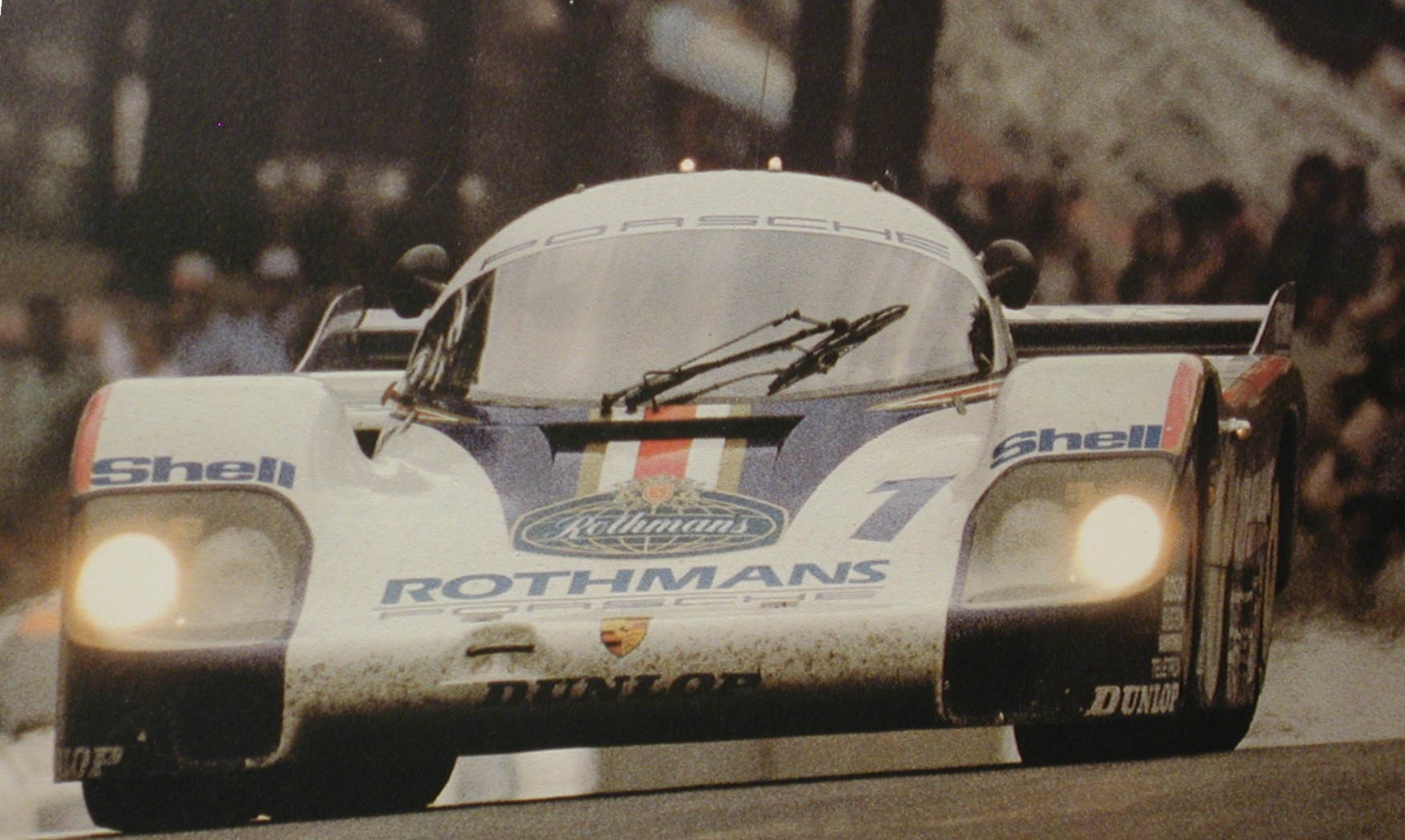
The creation of the “Group C” category for sports-prototypes in the early 1980’s was intended to bring fast and exotic cars back to the forefront of international racing, and the folks at Porsche were ready. In 1981 they laid the groundwork for the all-conquering 956. Powered by their already race-proven 2.6 liter turbo 6 (air cooled, but with water-cooled heads) the car brought Porsche a 1-2-3 finish at its first LeMans outing in 1982. In fact, the 956 and its slightly longer wheelbase variant, the 962, won LeMans for six consecutive years, from 1982 through 1987, including the “almost perfect” run in 1983, where 956s finished 1-2-3-4-5-6-7-8 and 10 (a lone Sauber C7 prevented it from being a clear sweep).
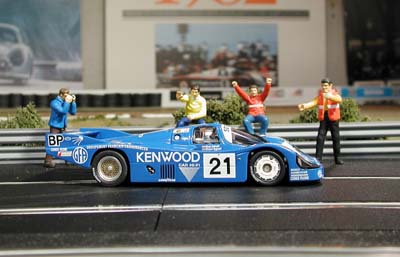
The first 956 released by Slot.it is one of the cars from that dominating 1983 run at LeMans. Piloted by Mario and Michael Andretti, along with Frenchman Philippe Alliot, the Kremer racing team entry finished third, just 6 laps behind the first- and second-place factory cars. The Kenwood sponsored #21 car is a beautiful medium blue with an assortment of crisp white sponsor markings. A handful of the markings, most noticeably the driver’s names and the LeMans Group C entry sticker, appear to be decals. The white sunshade at the top of the windshield as well as black markings to simulate weather-stripping are Tampo printed onto the clear windows and headlight covers. The entire car is finished in what I would consider a “satin gloss” rather than a show-car type high gloss. It is still plenty shiny, and I personally think it looks more like the real 956’s I’ve seen. There were no drips, dust specs, smears or other flaws in either the paint or Tampo work on my car, and Slot.it’s Chinese production facility appears to be well up to the task of turning out these fine models.
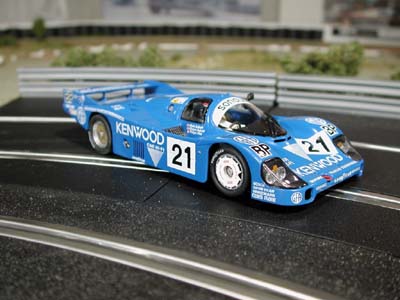
A full driver figure fills the interior, which is an extremely compact affair. The windshield and widows mount flush with the surrounding body work and Slot.it has used separate plastic detail pieces for the fuel fillers, side-mounted exhaust pipes and radiator grills. There is also a separate tow-hook in the front and a pair of high-mounted mirrors on either side of the cockpit. Four headlight lenses are tucked under clear covers up front and the rear lights are represented by clear red and yellow plastic lens. All the detail pieces are melt-fastened in place and fit snugly and quietly on my example – no irritating rattles! In addition, the wheels are set off by fantastic recreations of the aerodynamic trim piece normally fitted to the front wheels and fine photo-etched representations of BBS wheels in the rear.
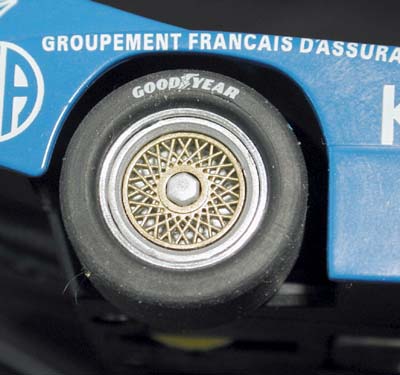
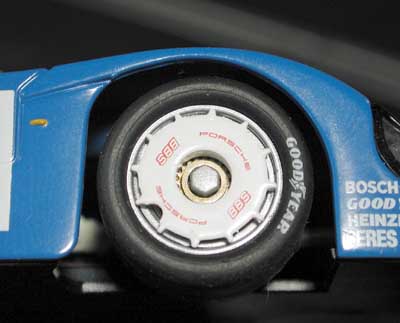
Keeping the shiny-side up is a simple matter, thanks to the wonderful chassis that Slot.it has created for this beast. A study in simplicity and refinement, the chassis is something every slot manufacturer should examine very closely. A sturdy flat pan with separate motor-mount, the classis kicks upward at the rear to follow the contour of the body and to simulate some of the ground-effects tunnels on the real car. The chassis connects to the body with two screws, one just behind the guide flag and the other just behind the crown gear.
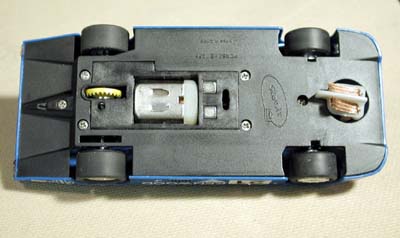
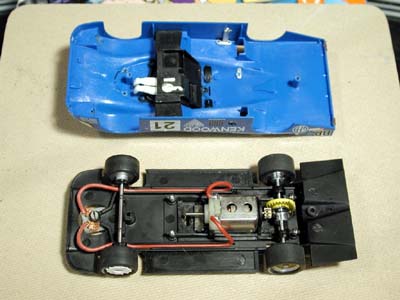
Slot.it mounts one of their “c” shaped bar magnets just ahead of the motor. The two thicker parts of that magnet protrude down through the motor-mount, getting them as close to the rails as possible. The standard magnet position is just ahead of the motor, but I am told that it is possible to fit one of Slot.it’s “reverse motor mounts,” allowing the magnet to be positioned just in front of the rear axle for additional grip. The chassis also has a cut-out for a spur gear, allowing for conversion to a sidewinder type motor-mount. In addition, there is ample room inside for a longer can motor, if you are shopping for even more power.
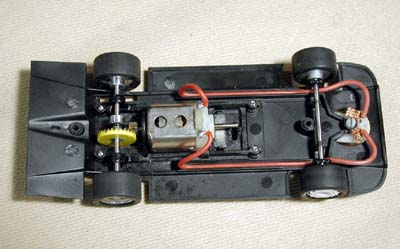
That being said, the stock motor appears to be Slot.it’s v12/2 – which is rated at 26,000 rpm at 12 volts – and seems more than adequate for the task of hustling this car around the track. I don’t have the equipment to measure revs, but I can tell you that this motor screams! Running at 12 volts on my test bench it sounds like it is pulling substantially higher revs than a Fly racing motor or a stock Scalextric Mabuchi can. Again, I based my judgment on the sound of these motors running on identical voltage. The motor is mounted with a 9-tooth pinion turning a 28-tooth crown gear.
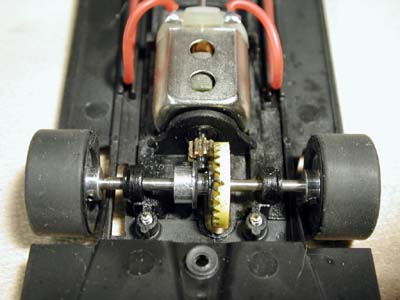
The crown gear is one of Slot.it’s beefy set-screw mounted gears, which is attached to a beautiful and straight rear axle. There are metal bushings press-fit into the motor mount, holding everything exactly where it should be, and the axle is capped at either end by Slot.it’s aluminum set-screw mount wheels. Most racers know these parts as prime after-market replacements for less-than-adequate parts on other cars, and they work extremely well in this installation. Running on my test bench with the body removed there was no trace of vibration or wobble in the drive train, just the smooth and quiet transmission of power.
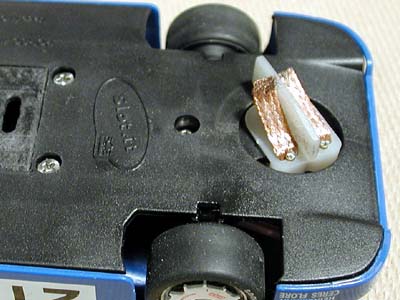
Up front you will find a beefy Slot.it guide flag, complete with a huge side-to-side swing – it can pivot almost 90-degrees to either side. Power slides should be a dream for those running this car without magnets. Also up front you will find a solid axle and plastic wheels. NOTE: There are two center pins which rise up out of the chassis, limiting the up/down play of the front axle. On my car they fit rather snugly against the axle, preventing the axle from spinning as freely as I normally like. I chose to remove an extremely small amount of material from these axle stops (just a few passes with fine sandpaper) which allowed the wheels to spin but not slop around. I decided to trim the posts rather than enlarge the axle holes mainly because I felt the close fit around the front bodywork would not allow much upward travel of the wheels.
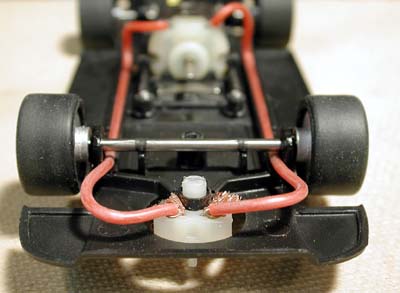
The lead wires tuck into slots on either side of the chassis, keeping them out of the way while allowing plenty of room for weight, additional magnets or additional details. Adding a lighting kit is one of my first priorities, and there is plenty of room for those pieces. The motor mount is a separate piece, attaching to the chassis with four screws and helping to reinforce the center section of the classis.
In most cases the biggest question people have about any new car is “how does it run?” The single-word answer is – SWEET. I had the chance to test the car on a friend’s 75-foot’ Scalextric Classic layout, which includes everything from a massive front straight to a pair of tight hairpins along with every combination in between. The motor and gearing combo for the 965 showed good acceleration out of the corners and plenty of power and acceleration down the straight. The magnet location gave ample cornering grip for my taste and did allow a little bit of sliding. As with any magnet car, you have to be quick to recover from any slide, but this car showed extremely good balance. The tires are soft, but also smoother than some of the more recent releases by Fly and Scalextric. Cornering grip would certainly improve with the installation of after-market silicone tires, allowing drivers to fine-tune the car to their own style and taste. I have not yet tested the car on smaller circuits, and the gearing may be a bit tall for extremely twisty circuits, but the assortment of Slot.it gears available should make tuning the car a fairly easy process.
During my particular testing session the Slot-it 956 was running lap times that were slightly better than a Fly Porsche 908 or a Scalextric GT-40 (which we happened to be running in league racing that day). For reference, both the 908 and GT 40 were running on silicone tires, while the 956 was fresh out of the box. The Slot.it seemed to have slightly better acceleration and top speed, but gave up a little cornering grip to the others, I believe mostly because of the tires. This car does not have the ultimate cornering grip of a Fly Lola B98 or Scalextric’s new IRL cars, but it does have the potential to be tuned to go that fast – if that is what makes you happy. What it does have is an extremely enjoyable and balanced combination of speed, grip and smoothness. Just like the real 956, the car just goes about its work quietly and easily, and I found it a blast to drive.
How accurate of a model is it? First and foremost, my eyeballs, personal encounters with real 956’s and comparisons to photos ID this as a very accurate recreation. Compared to published dimensions of the 1:1 scale Porsche, the Slot.it model is within 1%, or plus-or-minus 1 millimeter of the correct length, width and wheelbase. Close enough to be “spot on” in my book.
Additional versions of this car are pending from Slot.it, and they have plenty of material to choose from. 28 of the 956’s were built by Porsche, along with an additional 193 of the 962 version. On top of that, another 48 modified 962’s were created by shops outside the Porsche factory. All in all, this selection should keep Porsche fans and the folks at Slot.it busy for years to come!
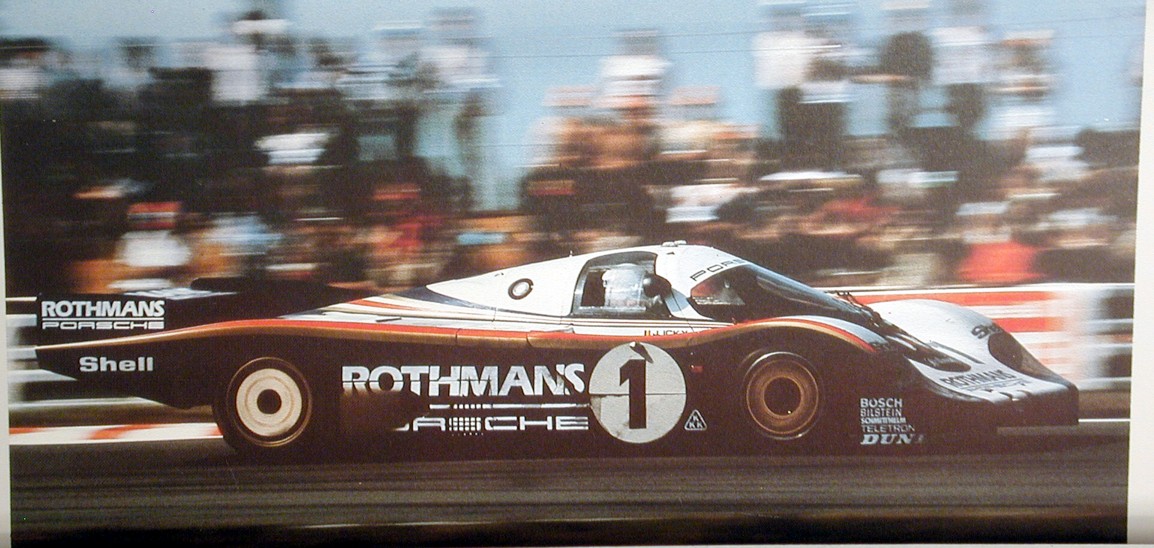
- Nils
Feel free to contact me at nilshf@earthlink.net, or check for “nilsnews” on the Home Racing World message forum.